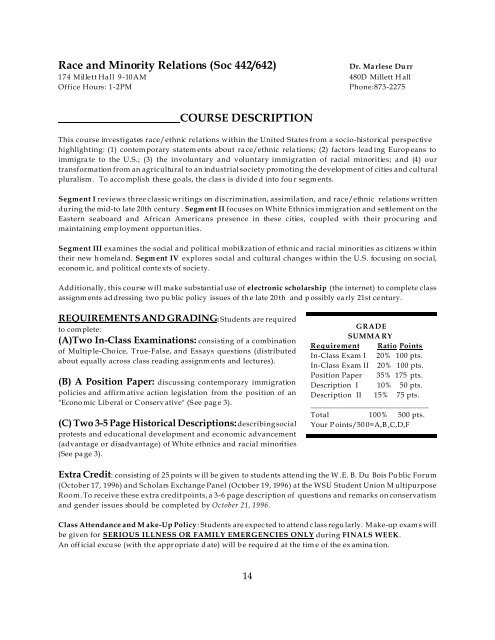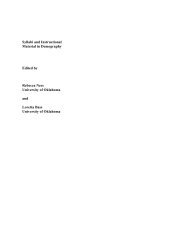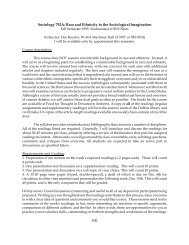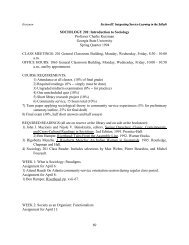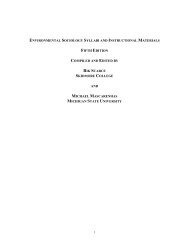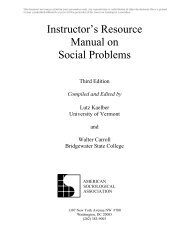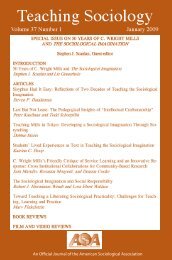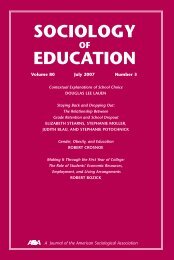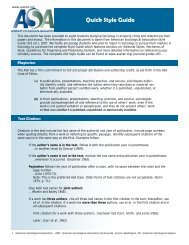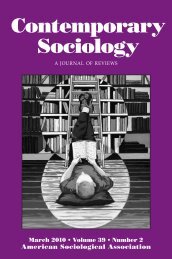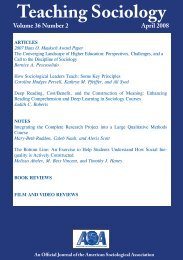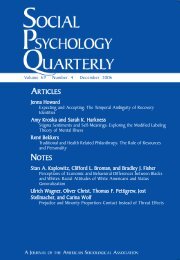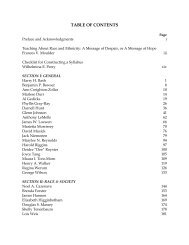Marlese Durr - American Sociological Association
Marlese Durr - American Sociological Association
Marlese Durr - American Sociological Association
You also want an ePaper? Increase the reach of your titles
YUMPU automatically turns print PDFs into web optimized ePapers that Google loves.
Race and Minority Relations (Soc 442/642) Dr. <strong>Marlese</strong> <strong>Durr</strong><br />
174 Millett Hall 9-10AM 480D Millett H all<br />
Office Hours: 1-2PM Phone:873-2275<br />
COURSE DESCRIPTION<br />
This course investigates race/ethnic relations within the United States from a socio-historical perspective<br />
highlighting: (1) contemporary statem ents about race/ethnic relations; (2) factors leading Europeans to<br />
immigrate to the U.S.; (3) the involuntary and voluntary immigration of racial minorities; and (4) our<br />
transformation from an agricultural to an industrial society promoting the development of cities and cultural<br />
pluralism . To accomplish these goals, the class is divided into fou r segments.<br />
Segment I reviews three classic writings on discrimination, assimilation, and race/ethnic relations written<br />
during the mid-to late 20th century . Segment II focuses on White Ethnics immigration and settlement on the<br />
Eastern seaboard and African <strong>American</strong>s presence in these cities, coupled with their procuring and<br />
maintaining employment opportunities.<br />
Segment III examines the social and political mobilization of ethnic and racial minorities as citizens w ithin<br />
their new homeland. Segment IV explores social and cultural changes within the U.S. focusing on social,<br />
econom ic, and political conte xts of society.<br />
Additionally, this course will make substantial use of electronic scholarship (the internet) to complete class<br />
assignm ents addressing two pu blic policy issues of the late 20th and p ossibly ea rly 21st ce ntury.<br />
REQUIREMENTS AND GRADING: Students are required<br />
to complete:<br />
(A)Two In-Class Examinations: consisting of a combination<br />
of Multip le-Choice, True-False, and Essays questions (distributed<br />
about equally across class reading assignm ents and lectures).<br />
(B) A Position Paper: discussing contemporary immigration<br />
policies and affirm ative action legislation from the position of an<br />
"Econo mic Liberal or Conservative" (See page 3).<br />
(C) Two 3-5 Page Historical Descriptions: describing social<br />
protests and educational development and economic advancement<br />
(advantage or disadvantage) of White ethnics and racial minorities<br />
(See pa ge 3).<br />
14<br />
GRADE<br />
SUMMA RY<br />
Requirement Ratio Points<br />
In-Class Exam I 20% 100 pts.<br />
In-Class Exam II 20% 100 pts.<br />
Position Paper 35% 175 pts.<br />
Description I 10% 50 pts.<br />
Description II 15% 75 pts.<br />
_____________________________<br />
Total 100% 500 pts.<br />
Your Points/50 0=A,B ,C,D,F<br />
Extra Credit: consisting of 25 points w ill be given to students attend ing the W .E. B. Du Bois Public Forum<br />
(October 17, 1996) and Scholars Exchange Panel (October 19, 1996) at the WSU Student Union M ultipurpose<br />
Room. To receive these extra credit points, a 3-6 page description of questions and remarks on conservatism<br />
and gender issues should be completed by October 21, 1996.<br />
Class Attendance and M ake-Up Policy: Students are expected to attend class regularly. Make-up exam s will<br />
be given for SERIOUS ILLNESS OR FAMILY EMERGENCIES ONLY during FINALS WEEK.<br />
An official excuse (with th e appropriate d ate) will be require d at the tim e of the ex amina tion.
TEXT(s): Aguirre. Adalberto, Jr. and Jonathan Turner. <strong>American</strong> Ethnicity:The Dynamics and<br />
Consequences of Discrimination. New York: Mc Graw Hill, Inc. 1995.<br />
Pedraza, Silvia and Rueben G. Rumbaut. Origins and Destinies: Immigration, Race, and<br />
Ethnicity in America. New York:Wadsworth Publishing Company, 1996.<br />
Required Reading Schedule<br />
A=Aguirre & Turner/ P=Pedraza & Rumbaut/R=Reserve<br />
Segment I Theoretical Considerations & Discussion<br />
9/18 Merton "Discrimination and The <strong>American</strong> Creed" (R)<br />
Gordon "Assimilation in America: Theory & Reality" (R)<br />
Wilson "The Declining Significance of Race" (R)<br />
Segment II Immigration & Settlement<br />
9/25 Chapter 1 Ethnicity and Ethnic Relation (A)<br />
Pedraza "Origins and destinies: Immigration, Race, and Ethnicity in <strong>American</strong><br />
History" (P)<br />
10/2 Chapter 2 Explaining Ethnic Relations (A)<br />
Chapter 3 The Anglo Saxon Core and Ethnic Antagonism (A)<br />
10/7 Rumbaut "Origins and Destinies: Immigration, Race, and Ethnicity in Contemporary<br />
<strong>American</strong> History" (P)<br />
10/9 Historical Description 1 Educational Development and Economic Advancement of White<br />
Ethnics and African <strong>American</strong>s in East coast cities during the la te<br />
19th and early 20th century.<br />
Segment III Urbanism & Race/Ethnic Relations<br />
10/9 Bender and Reimers "New York as an Immigrant City". (P)<br />
Chapter 7 Asian <strong>American</strong>s (A)<br />
10/11 Bozorgmed i et.al, "Los Angeles: Explosive D iversity". (P)<br />
Chapter 6 Latino/Hispanic <strong>American</strong>s (A)<br />
10/16 Grenier and Perez "Miam i Spice: The Ethn ic Cauld ron Sim mers". (P)<br />
10/21 Manning "Washington, D.C.: Th e Changing Social Landscape of Internationa l<br />
Capital City" (P)<br />
10/23 Exam I October 23, 1996<br />
Segment IV Social & Political Mobilization<br />
10/25 Chapter 4 African <strong>American</strong>s (A)<br />
Morris and Herring "The Civil Rights Movement: A Social and Political Watershed" (P)<br />
10/30 Chapter 5 Native <strong>American</strong>s (A)<br />
Cornell "<strong>American</strong> Indians and Political Protest". (P)<br />
11/6 Chapter 8 White Ethnic <strong>American</strong>s (A)<br />
Gold and Phillips "Mobility and Continuity Among Eastern European Jew s" (P)<br />
11/13 Historical Description 2 Social Protests and Political Mobilization by Asian and Latino<br />
<strong>American</strong>s in West Coast Cities in the mid-to-late 20th century.<br />
11/20 Exam II November 20, 1996<br />
11/25 Position Pa pers Immigration Policies & Affirmative Action Legislation<br />
15
"THE NET"<br />
Electronic Scholarship: used in this class involves the accessing of one of several internet search engines<br />
to locate on-line scholarship in the area of race\ethnicity for historica l and contemp orary issu es. This<br />
technology will be especially helpful in locating materials (since 1960) to construct your<br />
position papers on immigration policies and affirmative action legislation . More importantly, you will be ab le<br />
to access current information on these issues through the electronic newsstand (New York Times, Washington<br />
Post, Los Angeles Times). Additionally, a class newsgroup (Wright.Soc.Soc442) has been established for<br />
student-to-student and student-to-professor conversation about class readings and assignments. A<br />
mand atory atte ndance com puter w orkshop will be held Septe mber 20, 1996.<br />
The internet search engines are: Altavista, <strong>American</strong> Studies, Excite, Clearinghouse, Inktomi,<br />
Yahoo, and Galaxy. To access these web sites type the following : Lynx http://Libnet.Wright.Edu<br />
and tab to virtual reference and follow the directions found within the page.<br />
Writing Assignment Format<br />
All writing assignments should be type (double-spaced) with one inch margins and numbered in the lower<br />
right corner of the page. Papers will be graded on appearance, grammar, spelling, organizational format, and<br />
content. Each paper should be stapled (top left corner) with a cover page. The cover page must have the title<br />
of your paper (centered). Your name, course title and num ber, professor's name and quarter should be placed<br />
at bottom right of cover page (single spaced). Late writing assignments will receive a letter grade reduction<br />
for each day they are late. Handwritten assignments will receive an F (papers will not be returned, so make<br />
copies).<br />
INTERNET ASSIGNMENTS<br />
Historical Description I: is to be completed by October 9, 1996 should be a brief, but through discussion<br />
of the education development and economic advancement of White Ethnics and African <strong>American</strong>s during<br />
Reconstruction and the early 20th century. Historical Description II: due November 13, 1996 should<br />
discuss social protests and political mobilization of Asian and Latino <strong>American</strong>s in West coast cities during<br />
the mid-to late 20th century.<br />
A Position Paper: requires that you take the position of an "Economic Liberal" or "Economic Conservative"<br />
and develop a 7-10 position paper arguing for or against affirmative action legislaton and current<br />
immig ration po licies.<br />
Affirmative Action Position Paper<br />
Within your paper include a discussion on: (1) the Presidential Administration which developed and<br />
implemented Executive Order 11246; (2) what an Executive Order is; (3) the purpose of the order and which<br />
groups it spoke to and under what conditions; (4) the year the order took effect; (5) the pro's and con's of the<br />
order; (6) the California Civil Rights Initiative and 1996 presidential candidates positions on affirmative<br />
action. If you have taken the Economic Conservative position, provide solu tions to this p olicy. Economic<br />
Liberals should provide solutions on how to strengthen the current affirmative action policy.<br />
Immigration Policies Position Paper<br />
Within your paper include a d iscussion on: (1) the p urpose of im migration policies; (2) a brief history on<br />
immigration policies in the United States: (3) the pro's and con's of such policies; (4) Proposition 187; and (5)<br />
the 1996 p residential candidates position U.S. imm igration policies. If you ha ve taken the Economic<br />
Conservative Position, provide solutions to this policy. Economic Liberals should provide solutions on how<br />
to strengthen the current affirmative action po<br />
<strong>Association</strong> of Black Sociologist (ABS) Listserver: also contains texts of cu rrent articles of<br />
importance which address issues of race/ethnicity, from an African <strong>American</strong> perspective. Students may<br />
subscribe to the list by a ccessing e-mail and then typing: listserver@cmuvm.csv.ccmich.edu. In the body of<br />
the letter, type your request Sub Abslst-L. You will probably receive a message back from them welcoming<br />
16
you to the listserver. The missue of this listserver can result in some serious consequences, even the revoking<br />
of e-mail privileges<br />
RACE & MINORITY RELATIONS (SOC 442)<br />
Preparation Tips<br />
Each student should develop a "Question and Answer Outline" for assigned chapters, readings, and lecture<br />
notes. This outline will firm your grasp of key ideas, concepts, and theories. Remember, the subheadings<br />
in each chapter describes wha t will be discussed in each se ction. To b egin you r outline, you might ask:<br />
I. CHAPTER 1 ETHNICITY AND ETHNIC RELATIONS<br />
Q. What does this chapter discuss?<br />
A. This chapter discusses ethnicity and ethnic relations and focuses on the:<br />
1. definitions of race and ethnicity;<br />
2. definitions of mino rity groups, prejudice, and discrim ination;<br />
3. definitions of ethnic groups, stratification, prejudice.<br />
Q. How does the discussion of biological differences fit with these concepts?<br />
A. The discussion of biological difference fits with these terms because:<br />
(1)____________; (2.)___________; (3)_________________.<br />
Q. What is the difference between these concepts?<br />
A. The differen ce between prejudice and discrimination is that:<br />
Prejudice is defined as ____________________, while Discrimination<br />
describes _______________________.<br />
Q. How m any types of discrimination exist?<br />
A. At least ______ types of discrimination exist. They are:<br />
1. ____________________<br />
2. ____________________<br />
3. ____________________<br />
Q. What is the difference (or similarity) between ethnic, reverse, and<br />
institutional discrimination?<br />
A. _______________________________<br />
_______________________________<br />
_______________________________<br />
Write your questions and answ ers without the aid of your text or lecture notes to<br />
test your mem ory and reading comprehen sion.<br />
For all blank spaces (as well as filled in responses) return to your lecture notes<br />
and text to check your answers and fill in the correct response(s) in all open<br />
spaces. By continually refining and reviewing your outline, you are revisiting<br />
class lectures a nd text reading a second, maybe even a third time. Complete your<br />
17<br />
CHAPTER<br />
CONCEPTS<br />
Each chapter has<br />
concepts associated<br />
with theorist and<br />
theories.<br />
These concepts are<br />
usually bolded<br />
and/or italicized.<br />
Define each concept in<br />
the following manner:<br />
Ch.1 Ethnicity and<br />
Ethnic Relations<br />
Race is defined as__.<br />
Prejudice is ______.<br />
Subpopulation is ___.
total review using this method. 1<br />
THEORIST, MULTIPLE-CHOICE, AND TRUE-FALSE QUESTIONS<br />
Theorists contained in the chapter and chapter summaries enable you to link concept and theory development<br />
with a person and a person with a concept and theory. For example, Merton, La Piere, and Wirth are social<br />
theorist discussed in the first chapter (C hapter 1) of you r text.<br />
Table 1 displays a me thod for outlining th eorists, their writings, and concepts associated with their writings<br />
for each chapter. This same method may be used to review assigned articles (see Table 2). After reviewing<br />
these tables, prepare tables of your own. Your tables shou ld contain more information then these examples.<br />
Table 1 SOCIOLOGIST W HO DESCRIBE ETHNICITY ISSUES (Ch.1,2,3,5)<br />
Theorist Ideas on Race & Ethnicity Concepts<br />
Wirth People singled out for differential treatment Minority group<br />
Merton Personality Ty pes which discriminate All-Weather Liberal<br />
Table 2 SOCIOLOGIST WHO HAVE WRITTEN ABOUT RACE & ETHNICITY<br />
Author Article &M ain Points Concepts<br />
Gordon Assimilation in <strong>American</strong> Anglo-Conformity<br />
competing models on societal development and character Melting Pot<br />
Cultural Pluralism<br />
Wilson The Declining Significance of Race Underclass<br />
class more im portant than race after W WII<br />
description of the African Am erican middle-class<br />
description of the Underclass<br />
Comp lete Table 3 as you move through the class for each ethnic/racial group discussed. Your table heading<br />
will change as we discuss different groups (especially during the 19th & 20 th Century). But this table will<br />
give you and idea on how to prepare materials in texts and class lectures for examination.<br />
Table 3 White Ethnic Arrival and Settlement in Colonial America<br />
Ethnic Group Country of Origin Economic Conditions Date of Immigration<br />
Irish<br />
Scotch-Irish<br />
Germans<br />
Scandinavians<br />
Africans<br />
1 What do the concepts subpopulation, institutional discrimination, ethnic stratification, and<br />
ethnic discrimination mean? This a guide on how to prepare for the in-class exam.<br />
18


